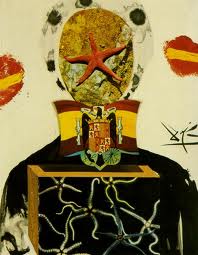
“The mermaids have come to the desert
They are setting up a boudoir next to the camel
Who lies at their feet of roses.”
These, too, have a Fortean ring. But, capturing what Fort mean to Lamantia is not so easy. The Fortean overtones in his other poems are less obvious; more to the point: as far as I know, he never wrote about Fort. It’s possible to offer a plausible reconstruction, though.
Let’s start with surrealism.
It is known, for instance, that surrealists were interested in Fort quite early. Robert Allerton Parker—who had discussed H. P. Lovecraft and Clark Ashton Smith in the pages of VVV—made note of Charles Fort in the catalog of the International Surrealist Exhibition of New York, 1942:
“This Socrates of the Bronx . . . was primarily a collector of newspaper clippings; out of these clippings, by a craft of literary collage and montage, Fort managed to project his picture of a paradoxical and highly unpredictable universe. He was a connoisseur of the incredible—a snatcher up of unconsidered, yet disconcerting, trifles—the alogical, the illogical, the analogical, the neological.”
These were Lamantia’s interests, too—the alogical, illogical, analogical, and neological continuities of his poems. There are other connections between Fortean thought and Lamantian surrealism, as well. Although Fort argued he was not interested in the miraculous—he thought his findings mundane, at least according to his philosophy—there is no doubt that he was attracted to the “marvelous”: those things that make us marvel, to consider the construction of reality. This was a prime interest of Lamantia, too—“the touch of the marvelous” in his poem grew, in part, out of a surrealist understanding of the marvelous.
In the first surrealist manifesto (written in 1924, three years before Lamantia was born—a reminder of how young he was when he started), Andre Breton wrote,
"Let us not mince words: the marvelous is always beautiful, anything marvelous is beautiful, in fact only the marvelous is beautiful."
Fort and surrealism share an aesthetic appreciation of the world, of the unusual—there is beauty in things like rains of frogs and fields of periwinkles.
It is also likely that Lamantia, at least in his first surrealist incarnation, was drawn to Fort’s materialism. Lamantia, as noted, saw himself and surrealism carrying on the tradition of dialectical materialism. Fort was not interested in occultism or esotericism, but material, physical things that resisted conventional explanations. Given these various connections, then, one can see how Lamantia—like Cherkovski—was interested in Fort not (or not only) as a source of odd facts, but as rescuing the marvelous and embedding it into a kind of poem, a collage or montage—or, like Lamantia’s own poem (and like certain esoteric practices) almost a form of automatic writing. These may not have been Fort’s understandings of his own works, but the ease with which he was translated into surrealistic terms would explain Lamantia’s interest.
Beyond that, there are certain . . . let’s call them metaphysical . . . aspects of Fort’s writings that would have appealed to Lamantia, even after his break with surrealism, and search for the mystical—an ineffable world beyond the material.
There are a couple of bits of evidence that support this supposition. First, Lamantia maintained a lifelong interest in other outré beliefs, such as Atlantis, and Mu, closely related to Fort, and the writer Clark Ashton Smith, whose weird tales also—as noted—have elective affinities with Fortean writing. In 1985, Lamantia traveled to Auburn, California for the third time in his life—all those times related to Smith (His remarks are in his papers at the University of California, Berkeley). This visit was to dedicate a plaque honoring Smith. In his remarks he divided reality into three parts: the material world, ineffable world, and imaginative world. Smith, he said, was an explorer of this third realm, and Fort would seem to fit here, too. Thus, although Fortean materialism would have appealed to Lamantia during his early surrealist period, interest in Fort might have survived his dropping materialism, too, since it was possible to see Fort not as an explorer of (just) the world, or the divine, but of the imagination.
A second bit of evidence can be inferred from Lamantia’s letters in support of his conscientious objector status during the years after World War II. Lamantia argued that God was reality, and humankind had separated itself from God through its intellect. Fort did not make the same argument, but one that was similar. Fort maintained that human-made classes and categories obscured some parts of reality: and that accounts for the existence of damned facts, true, unaccountable things that no one credits. For both, it was human “knowledge” that separated us from reality.
Finally, there is the writing style that Lamantia adopted for the poems written after his break with surrealism and collected in Tau (unpublished until 2008). Joseph Henry Jackson, supposedly reporting a comment made by Thayer, said (twice) that Fort’s wrote as though with a charred piece of redwood on the face of a cliff—quick, slashing, dashing. (Indeed, Fort often replaced a period with a dash.) Lamantia’s style in Tau was like that, too. The lines are assertive, not introspective as they were in his earlier works. From “Shot into the Sun,” chosen as an example pretty much at random:
“The marigold space empties
Into solar hieroglyphs.”
Or, from an untitled poem:
"Flame gates open to water gongs:
Roll to the wayward depth
Before & After the caves of Sol"
